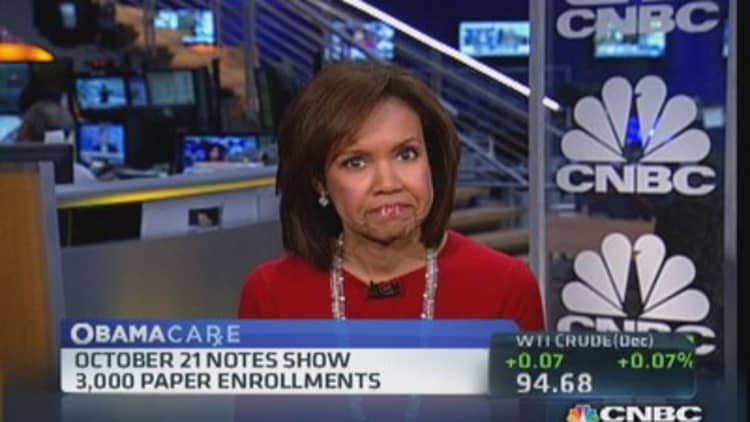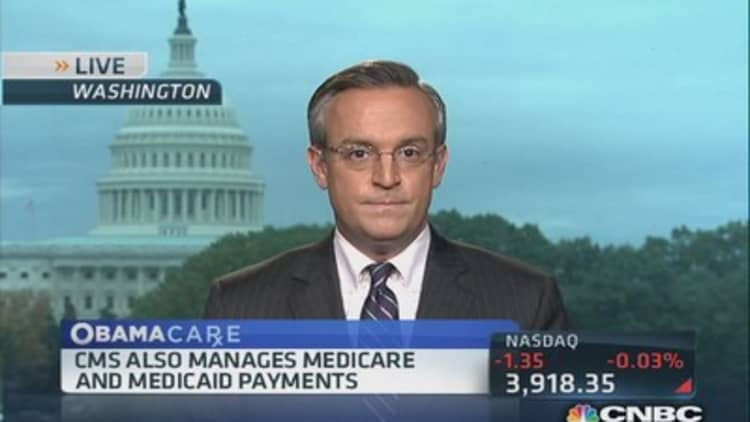The Obamacare door is open—but few are going inside to check things out, so far.
Just 17 percent of people potentially eligible for Obamacare insurance have visited new government-run health marketplaces such as tech-troubled HealthCare.gov to shop for coverage since they opened Oct. 1, a new study released Monday found.
And just 1 in 5 of those visitors said they had actually enrolled in a health plan either online, in person, on the phone or via mail, according to the Commonwealth Fund survey, which questioned people without insurance or those who already have individual policies.

The relatively paltry numbers echo U.S. Health and Human Services Secretary Kathleen Sebelius, who last week told a congressional committee that she expected to see a low level of enrollment in Obamacare insurance when HHS releases enrollment data for the first time this month.
But HHS officials have repeatedly noted that the open-enrollment period for that insurance continues through March 31, and that they expect many more people to apply for coverage by then.
(Read more: Hillary running ... away from Obama)
Contractors are racing to fix the tech-crippled HealthCare.gov site before Dec. 15, which is the date by which people have to enroll in coverage for it to begin Jan. 1.
"The unveiling of the Affordable Care Act's central coverage provisions this month has been anything but smooth," the Commonwealth Fund survey said. "That reality is reflected in the survey findings.
Nearly 40 percent of the people who visited the marketplaces reported having technical difficulties with HealthCare.gov or one of the other state-run markets. And the overwhelming majority of visitors—70 percent—rated their experience as fair or poor; just 27 percent called the experience good or excellent.

The Commonwealth Fund study found a markedly higher level of awareness about the new insurance marketplaces.
Sixty percent of those surveyed said they knew about the marketplaces. That's about a 33 percent increase from the awareness level in a Commonwealth Fund study earlier this year.
But just 53 percent of the respondents were aware that government subsidies are going to be available to many people who buy insurance from the marketplaces, also known as exchanges. And nearly half of those who visited the marketplaces said they weren't sure they could afford a plan.
(Read more: Insurance cancelled? Take a deep breath, and check out these options)
However, 58 percent of the respondents who have not yet enrolled in coverage said they are likely to try to enroll, or seek out information about available subsidies to obtain coverage by the end of March.
The new study was based on interviews with 682 people between the ages of 19 and 64 who are potentially eligible for Obamacare insurance. The survey, which was conducted from Oct. 9 through 27, had a margin of error of plus or minus 4.3 percent.
"While it is disappointing that so many people have had difficulty accessing the online marketplace, the survey results show that awareness of the marketplaces has grown this fall, and those who initially struggled appear determined to try again," said Sara Collins, vice president for health-care coverage and access at Commonwealth Fund, and the survey's lead researcher.
Starting in 2014, nearly all Americans will be mandated to have health insurance coverage by President Barack Obama's Affordable Care Act by March 31, or face a tax penalty.
(Watch: Will Obamacare increase your premiums)
The majority of Americans already have insurance through their employer's group plans, their parents' insurance or through government-run Medicare insurance for the elderly, or Medicaid for lower-income people. But about 47 million people last year did not have insurance.
The federal site HealthCare.gov—which is selling insurance in 36 states—and the 15 online health exchanges being individually run by the remaining states and District of Columbia were set up to sell insurance to the uninsured, and to people who already were buying individual policies. All of the exchanges are offering a range of insurance plans from competing prices, but all will have new minimum covered benefits mandated by the ACA.
Officials have estimated that about half of the 7 million people they hope to sign up in the first year will be eligible for at least some subsidy to offset the costs of coverage because their adjusted gross income will be less than 400 percent of the federal poverty level.
—By CNBC's Dan Mangan. Follow him on Twitter @_DanMangan


